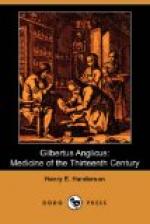In young persons, he tells us, recent ruptures of the siphac may be cured by appropriate treatment. The patient is to be laid upon his back, the hips raised, the intestines restored to the abdominal cavity and the opening of exit dressed with a plaster of exsiccative and consolidating remedies, of which he furnishes a long and diversified catalogue. He is also to avoid religiously all exercise or motion, all anger, clamor, coughing, sneezing, equitation, cohabitation, etc., and to lie with his feet elevated for forty days, until the rupture (crepatura) is consolidated. The bowels are to be kept soluble by enemata or appropriate medicines, and the diet should be selected so as to avoid constipation and flatulence. A bandage or truss (bracale vel colligar) made of silk and well fitted to the patient is also highly recommended. If the patient is a boy, cakes (crispelle?) of consolida major mixed with the yolk of eggs should be administered, one each day for nine days before the wane of the moon. If, however, the rupture is large in either a boy or an adult, and of long standing, whether the intestine descends into the scrotum or not, operation, either by incision or by the cautery offers the only hope of relief. Singularly enough too, while Roger devotes to the operation for the cure of hernia nearly half a page of his text, Gilbert dismisses the whole subject in a single sentence, as follows:
Scindatur igitur totus exitus super hac cute exteriori cum carne fissa, et uatur y fac cum file serice et acu quadrata. Deinde persequere ut in exitu intestini per vulnus superius demonstratum est (f. 281d).
Turning now to the title “De hernia” (f. 289b), Gilbert tells us “Swelling (inflatio) of the testicles is due sometimes to humors trickling down upon them (rheumatizantibus), sometimes to abscess, or to gaseous collections (ventositate), and sometimes to escape of the intestines through rupture of the siphac.” He adds also: “Some doubt the propriety of using the term hernia for an inflation. On this point magister Rn says: There is a certain chronic and inveterate tumor of the testicles, which is never cured except by means of surgery, as e.g., hernia. For hernia is an affection common to the scrotum and the testicles.”
The apparent confusion between these two passages is easily relieved by the explanation that inguinal or other herniae not extending into the scrotum are called by Gilbert ruptures of the siphac, but scrotal hernia is classed with other troubles located in the scrotum as hernia. Accordingly hernia, with Gilbert, includes not only scrotal hernia, but also hydrocele, orchitis, tumors of the testicles, etc. This is apparent, too, in his treatment of hernia, which consists usually in the employment of various poultices and ointments, bleeding from the saphena, cups over the kidneys, etc., though hydrocele is tapped and a seton inserted. If the testicle itself is “putrid,” it should be removed; otherwise it is left. It may be remarked en passant that the surgeons of medieval times, in their desire for thoroughness, often displayed very little respect to what Baas calls “the root of humanity.”




